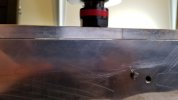Matthew Gregory
Chief Executive in charge of Entertainment
- Joined
- Jan 12, 2005
- Messages
- 6,377
As I'm sure many of you have seen, I've had quite a few issues with my KMG grinder. Some of that I've done to rectify things can be seen here:
https://www.bladeforums.com/threads/converting-a-kmg-to-direct-drive.1351035/
Brian Fellhoelter touched upon other bits in this thread:
https://www.bladeforums.com/threads/kmg-grinder-tweaks-thread.831688/
There are plenty of others, but I think you get the point.
As a result of my modifications, and my friend Joe selling a LOT of the direct drive kits shown in the thread above, I've fielded a lot of questions regarding troubleshooting these machines. One issue pops up quite a bit...
Although I freehand grind everything, I use a LOT of different attachments. All have their own tool arms. Many of these I've made, but some are just bone stock, like the platen attachment. The stock platen body is 1/2" thick plate 6061 aluminum, and one of the issues I think is how they're manufactured. I don't know this as a fact, but it's my guess that the 1/2"-13 threaded holes for the 1/2" hardware store bolts Rob uses for axles aren't spot drilled, bored, and cut with threadcutting endmills in a cnc, but rather just sloppily drilled and tapped. IT IS THE EXCEPTION, not the rule, for these to not be skewed. I own three of these platens, and none of them are square, and some are as far off as 3º. To help place this in context, the crowning applied to most drive and tracking wheels is 1º.
...and we wonder why the belts charge all over hell and high water.
I've toyed with the idea of drilling all of mine out and installing new inserts like helicoils or Acme keylocking threaded inserts, but I'm wondering if there's a better way, or if I'm just better off making my own damn platen attachment.
I'm always striving to improve my skills. For me, making a knife isn't necessarily about finding ways to increase efficiency, or doe things faster or easier. I want to make HAND MADE knives, meaning made with my two hands. I don't begrudge anyone doing things with rests, or jigs, or any other such methods - I just enjoy the challenge of working to the best of my ability. It's gotten to the point where many of my problems are due to the limitations of the machines I use, and this misalignment is a bit part of that.
Have any of you guys thought about this?
https://www.bladeforums.com/threads/converting-a-kmg-to-direct-drive.1351035/
Brian Fellhoelter touched upon other bits in this thread:
https://www.bladeforums.com/threads/kmg-grinder-tweaks-thread.831688/
There are plenty of others, but I think you get the point.
As a result of my modifications, and my friend Joe selling a LOT of the direct drive kits shown in the thread above, I've fielded a lot of questions regarding troubleshooting these machines. One issue pops up quite a bit...
Although I freehand grind everything, I use a LOT of different attachments. All have their own tool arms. Many of these I've made, but some are just bone stock, like the platen attachment. The stock platen body is 1/2" thick plate 6061 aluminum, and one of the issues I think is how they're manufactured. I don't know this as a fact, but it's my guess that the 1/2"-13 threaded holes for the 1/2" hardware store bolts Rob uses for axles aren't spot drilled, bored, and cut with threadcutting endmills in a cnc, but rather just sloppily drilled and tapped. IT IS THE EXCEPTION, not the rule, for these to not be skewed. I own three of these platens, and none of them are square, and some are as far off as 3º. To help place this in context, the crowning applied to most drive and tracking wheels is 1º.
...and we wonder why the belts charge all over hell and high water.
I've toyed with the idea of drilling all of mine out and installing new inserts like helicoils or Acme keylocking threaded inserts, but I'm wondering if there's a better way, or if I'm just better off making my own damn platen attachment.
I'm always striving to improve my skills. For me, making a knife isn't necessarily about finding ways to increase efficiency, or doe things faster or easier. I want to make HAND MADE knives, meaning made with my two hands. I don't begrudge anyone doing things with rests, or jigs, or any other such methods - I just enjoy the challenge of working to the best of my ability. It's gotten to the point where many of my problems are due to the limitations of the machines I use, and this misalignment is a bit part of that.
Have any of you guys thought about this?


